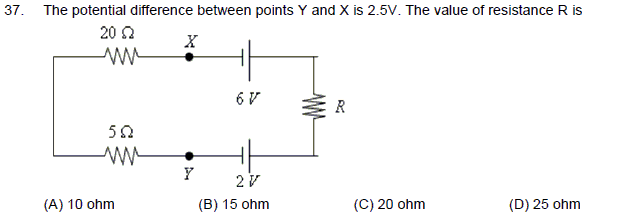dare to electricity
Level
pending
 solve it and please post a soution soon
solve it and please post a soution soon
10
20
15
16
This section requires Javascript.
You are seeing this because something didn't load right. We suggest you, (a) try
refreshing the page, (b) enabling javascript if it is disabled on your browser and,
finally, (c)
loading the
non-javascript version of this page
. We're sorry about the hassle.
The polarities of the 6 − V and 2 − V voltage sources are opposite, therefore the resultant equivalent voltage source is a 4 − V ( 6 − 2 ) source in place of the 6 − V source, while the 2 − V source is replaced with a short-circuit. The resultant equivalent circuit is a 4 − V source in series with R , 5 − Ω and 2 0 − Ω resistors.
Since the potential difference V X Y between X and Y is 2 . 5 V , then the current in the circuit is given by:
I = 5 + 2 0 V X Y = 2 5 2 . 5 = 0 . 1 A
The potential difference V R across R is given by:
V R = 4 − V X Y = 4 − 2 . 5 = 1 . 5 V
⇒ R = I V R = 0 . 1 1 . 5 = 1 5 Ω